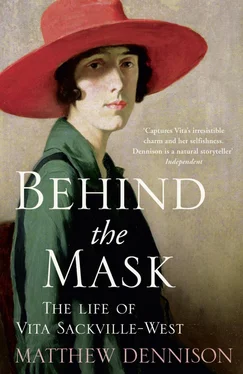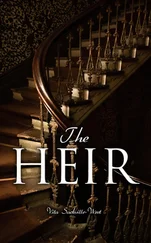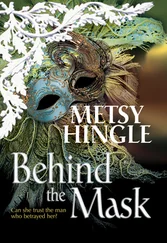PREFACE
PROLOGUE: Heritage
PART I: The Edwardians
PART II: Challenge
PART III: Invitation to Cast Out Care
PART IV: Orlando
PART V: The Land and the Garden
PART VI: All Passion Spent?
PICTURE SECTION
NOTES
BIBLIOGRAPHY
INDEX
ACKNOWLEDGEMENTS
BY THE SAME AUTHOR
ABOUT THE PUBLISHER

1. Vita by Philip Alexius de László, oil on canvas, 1910 (© National Trust Images/John Hammond )
2. Vita with her mother; Vita with her father
3. Knole; King’s Bedroom, Knole (© English Heritage )
4. Harold, Vita, Rosamund Grosvenor and Lionel Sackville on their way to court; Vita and her parents ( Photo by Hulton Archive/Getty Images )
5. Vita as Portia by Clare Atwood, oil on canvas, 1910 (© National Trust Images )
6. Vita and Mrs Walter Rubens (© Illustrated London News Ltd/Mary Evans ); Vita (© Illustrated London News Ltd/Mary Evans )
7. Sir Harold Nicholson, c. 1920 (© Private Collection/Bridgeman Images ); Vita at Ascot with Lord Lascelles ( Photo by Hulton Archive/Getty Images )
8. Violet Keppel by Sir John Lavery, oil on canvas, 1919 (© National Trust Images )
9. Vita and her two sons ( Photo by Hulton Archive/Getty Images )
10. View of Long Barn, Kent, in Winter by Mary Margaret Garman Campbell, oil on paper, c. 1927–8 (© National Trust/Charles Thomas )
11. Vita at the BBC (© BBC/Corbis ); Vita in sitting room at Long Barn with her sons (© Hulton-Deutsch Collection/CORBIS )
12. Vita (© Mary Evans/Everett Collection )
13. Dorothy Wellesley by Madame Yevonde (© The Yevonde Portrait Archive ); Virginia Woolf ( Photo by Mondadori Portfolio via Getty Images ); Hilda Matheson by Howard Coster (© National Portrait Gallery, London )
14. Sissinghurst Tower (© Niek Goossen/Shutterstock ); White Garden at Sissinghurst (© Eric Crichton/CORBIS )
15. Vita by John Gay, 1948 (© National Portrait Gallery, London ); Vita in the Sissinghurst Tower by John Hedgecoe, 1958 (© 2006 John Hedgecoe/Topham/The Image Works )
16. Vita’s desk by Edwin Smith, 1962 (© Edwin Smith/RIBA Library Photographs Collection )
VITA SACKVILLE-WEST ONCE described herself as someone who loved ‘books and flowers and poetry and travel and trees and dragons and the wind and the sea and generous hearts and spacious ideals and little children’. 1Later she added that she loved ‘literature, and peace, and a secluded life’. 2
There is no reason to doubt her. ‘Books and flowers and poetry’ became the outward purpose of her life: at the time of her death she was famous twice over, as a writer and a gardener. She never lost the taste for travel that began during her enormously privileged childhood; at home, she balanced curiosity and wanderlust with a powerful need for solitude (‘peace, and a secluded life’). Her love of nature – ‘trees and … the wind and the sea’ – is among her defining attributes as a poet and a novelist. It also shaped her understanding of the role of the landowning aristocracy to which she belonged, and in particular of her own role as a dispossessed aristocrat in the twentieth century. I interpret those ‘dragons’ symbolically. Vita was an extravagant dreamer. Her self-perception was shaped by myths and fairy tales. Intensely imaginative, like many artists she realised early in her life the subjectivity both of reality and realism. She valued intensity of feeling. She once described the ideal approach to life as ‘the ardour that [lights] the whole,/ Not expectation of that or this’. 3And she admired – and inclined to – lavishness. ‘I like generosity wherever I find it.’ 4
As in most lives, Vita defined ‘spacious ideals’ to suit herself. So too, although with greater particularity, ‘generous hearts’. These are the qualities which overwhelm Vita’s posthumous reputation. Since publication more than forty years ago of her confessional autobiography, written in 1920, in which she described her passionate affair with her childhood friend Violet Keppel, Vita’s literary achievements and the plantsmanship of her garden at Sissinghurst Castle have played second fiddle to her role as lesbian icon. Vita’s affair with Violet Keppel, described in Portrait of a Marriage , changed her life; it altered the course of what has become one of the best-known marriages of the last century, to diplomat, politician and writer Harold Nicolson, himself predominantly homosexual.
I suggest that this affair defines Vita as a person only to the extent that it demonstrates her determination to realise in her life the fullest possible understanding of the terms ‘spacious ideals’ and ‘generous hearts’. In arriving at working definitions of those terms, Vita hurt herself and others too, including her husband and her own ‘little children’, Ben and Nigel Nicolson. She was occasionally selfish, occasionally cruel. Jilted lovers threatened physical violence and legal action; on one occasion, Vita was forced to wrestle a pistol out of a lover’s grip; amorous entanglements forced Vita to deception and concealment. Neither her selfishness nor her cruelty was deliberate; blind to the small scale, she was without pettiness. ‘To hope for Paradise is to live in Paradise, a very different thing from actually getting there,’ she once wrote. 5She was a lifelong romantic, who understood herself well enough to recognise the slipperiness of her grasp on happiness. Her quest was for ‘beauty and comprehension, those two smothered elements which hide in all souls and are so seldom allowed to find their way to the surface’. 6
We should not lose sight of the ‘irresistible charm’, remembered by those closest to her, her ‘nobility and grandeur … largeness and generosity in everything she did or said or felt’ – but must set against it the vehemence of her need for privacy and her obsessive secrecy. 7Even her immediate family sometimes had no idea of Vita’s current literary project.
Vita consistently legitimised her peccadilloes in her writing. Internal debates, the need for secrecy among them, were played out in black and white on the printed page, albeit in the case of her sexuality in necessarily disguised form. Of the heroine of her best novel, All Passion Spent , Vita wrote in 1930, ‘Pleasure to her was entirely a private matter, a secret joke, intense, redolent, but as easily bruised as the petals of a gardenia.’ 8It was Vita’s own mission statement as faithless wife and lover. Through concealment, she achieved the compartmentalisation of her life that was essential to her. She rationalised it unapologetically as ‘carry[ing] one’s life inside oneself’. 9
The equation of pleasure and privacy was fundamental to Vita. She rebelled behind closed doors or within the safety of a small circle of friends gathered frequently from her own elite background. She did not advertise her transgressions, but maintained her ‘secluded life’. She once described the literary hostess Lady Ottoline Morrell as ‘a very queer personality … with masses of purple hair, a deep voice, teeth like a piano keyboard and the most extraordinary assortment of clothes, hung with barbaric necklaces … a born bohemian by nature’. 10Vita never imagined herself ‘a born bohemian’. Her identity as daughter of Knole, the great Sackville house in Kent, overruled all other personae.
Читать дальше













